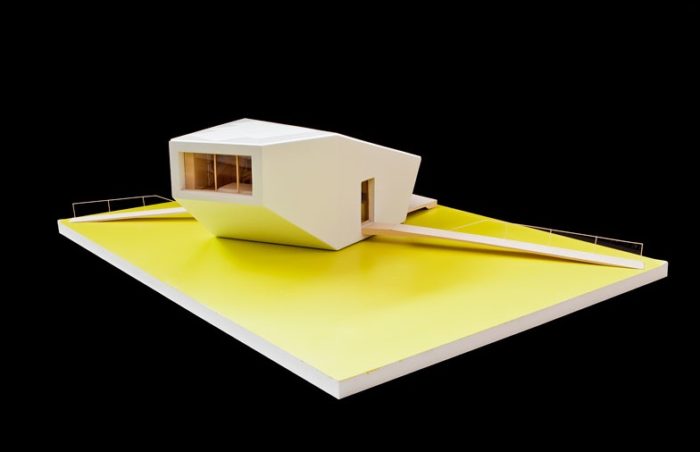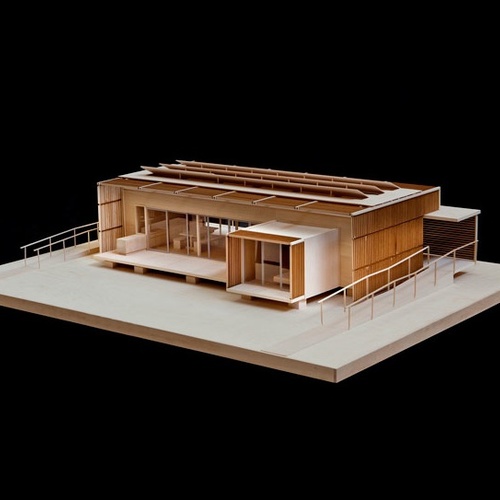
Image Credit: Southern California Institute of Architecture and California Institute of Technology
Image Credit: Southern California Institute of Architecture and California Institute of Technology In the early stages of the CHIP design, the SCI-Arc/Caltech team started with a cube and then elongated it to a 600-sq.-ft. footprint to increase the solar exposure on the roof. The underside of the building’s north end is cantilevered to create a carport. Insulation-filled batts were attached to the outside of the exterior wall and roof sheathing, a system the CHIP team calls “outsulation.” The system calls for polymer-coated vinyl to be wrapped over the batts to provide a rainscreen and seal off air leaks. The downward-sloping south nose of the house and its upward-pointing north end are designed to facilitate heat flow. Visitors entering the building will see the opposing-side entry straight ahead. The kitchen is to the right of the distant doorway. CHIP’s tiered interior, looking north. The 800-sq.-ft. interior is on five levels. Looking south from the northernmost tier in the CHIP interior.
For the Solar Decathlon team representing Southern California Institute of Architecture and California Institute of Technology, otherwise known as SCI-Arc/Caltech, beauty is, in many ways, skin deep. The skin of the team’s house – called CHIP, which stands for Compact House Increasing Possibilities, but also Compact Hyper-Insulated Prototype – is a system of cellulose-filled batts fastened in layers to the outside surface of the sheathing on the roof and exterior walls. The batt-covered shell is wrapped in architectural grade polymer-coated vinyl whose seams are sealed for airtightness and water resistance. Taken together, the insulation and wrapper will produce an 11-in.-thick blanket of what the SCI-Arc/Caltech team calls “outsulation,” which makes the polygonal house look a giant, quilted abstract sculpture. Cost considerations factored into the selection of the wrapper fabric – polytetrafluoroethylene fiberglass (marketed as PTFE fiberglass, a Teflon-coated woven fiberglass fabric) was the first choice, but too expensive. Poly-coated vinyl was found to be nearly as durable in tests conducted by the team, which has engineered CHIP to perform equally well in Washington, D.C.’s wide-ranging seasonal weather and in the relatively warm, arid, and sometimes very rainy climate of Southern California.
Live at the International Builder’s Show
Beyond photovoltaics
Convenience also came into play: the batt-and-fabric insulation system is relatively easy to transport, one CHIP team member noted in a blog post, adding, “I’m convinced that the fabric exterior will yield a truly distinctive design that beautifully suits our needs.” The building’s shape is derived from a cube that conformed to the maximum size the structure could be and still be easily shipped. The cube was then stretched and trimmed in ways that would enhance the sun exposure of the 16 Sanyo HIT (heterojunction with intrinsic thin layer) 210-watt solar panels on the roof and also would cantilever the north end to create a carport (a concession to L.A. car culture). The 800-sq.-ft. house, which features a five-level interior, breaks up into four sections for shipping.
Follow the CHIP team
Get the CHIP 2011 Blog widget and many other great free widgets at Widgetbox! Not seeing a widget? (More info)
Mechanicals SCI-Arc/Caltech’s calculations show that the house, when occupied, will consume about 21 kWh per day, with most of the electrical power used for air conditioning, laundry, and kitchen appliances. Lighting is handled by a combination of solar tubes, CFLs, and dimmable and non-dimmable LED bulbs. The CHIP engineering crew noted it aimed for a mechanical system that would “optimize the tradeoff between energy savings” and the cost of the photovoltaic system. To that end, CHIP’s mechanical system will include a 130-gallon thermal storage water tank for both heat storage and heat transfer between the home’s ductless heat pump – a Mitsubishi MXZ-2B20NA outdoor unit – and, for cooling, two Mitsubishi SEZ-KD09NA fan-coil units with a total capacity of 1.5 tons. Domestic hot water will be supplied by a 50-gallon GE GeoSpring hybrid electric heat pump water heater – selected over a solar thermal system, the team says, to maximize the PV panel coverage on the roof.
For an overview of the Solar Decathlon teams, see GBA’s 2011 Solar Decathlon Resource Guide
Weekly Newsletter
Get building science and energy efficiency advice, plus special offers, in your inbox.















One Comment
CHIP
It's remarkable that the entry from two Southern California institutions architecturally treats the outdoors as something to be closed away from and shielded against - almost feared. We have one of the best, most moderate climates in the world here, yet this building screams "Come inside and seal yourself away from the horrible outdoors !"
While funky angles have for the past 30+ years pretty much guaranteed a nice cover spread in any of the periodicals, I think a Neutra-esque approach of passive solar and natural ventilation would be a better, more engaging entry from this region.
Log in or create an account to post a comment.
Sign up Log in